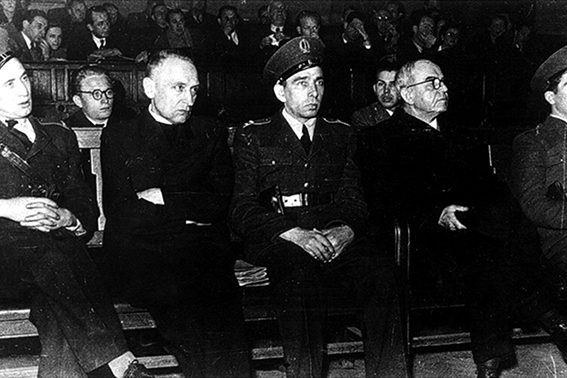La percepción de la arquitectura eclesial latinoamericana en la época del Concilio Vaticano II
Estudios desde la Europa centro-oriental
DOI:
https://doi.org/10.17979/aarc.2015.4.0.5118Palabras clave:
Europa del Este, organización del espacio, sistemas de planeamiento litúrgico, opresiónResumen
Los acontecimientos de la Segunda Guerra Mundial dieron lugar a cambios sociales muy significativos desde 1945. Mientras que en la mayor parte del mundo católico el principal motivo que había detrás de los intentos de transformar el espacio sacro católico era la definición de una Iglesia centrada en Cristo, resultado de un proceso natural, interno, estos cambios no hicieron efecto en los países del Este de Europa ocupados por la Unión Soviética, porque la religión y todas sus manifestaciones fueron duramente perseguidas con la excusa del orden mundial recientemente establecido. Los poderes políticos que defendían ideologías de raíz comunista y atea consideraban a la Iglesia como el principal oponente a su propio sistema de poder. No sólo en el sentido ideológico, sino también por la propia estructura organizativa de la Santa Sede, que traspasa las fronteras estatales. El artículo interpreta la presencia de los efectos de las reformas litúrgicas en correspondencia con la política oriental de la Santa Sede.
Descargas
Referencias
Balogh, Margit. 1997. «Egyházak a szovjet rendszerben (1945–1989)» [Churches in the Soviet system
(1945-1989)]. In Magyarország a XX. században. 2. köt., edited by Tarsoly I. Kolléga, 386-439. Szekszárd:
Babits Kiadó
Balogh, Margit. 2014. «Diplomatic Missions of the Holy See in Hungary and East-Central Europe after the Second World War». Central European Papers 2/1:88-114.
Berglund, Bruce R. and Brian Porter-Szûcs. eds. 2010. Christianity and Modernity in Eastern Europe. Budapest/New York: Central European University Press.
Biedrzynski, Richard. 1958. Kirchen unserer zeit. München: Hirmer Verlag.
Cetto, Max. 1961. Moderne architektur in Mexico. Stuttgart: Verlag Gerd Hatje.
Christ-Janer, Albert, and Mary Mix Foley. 1962. Modern church architecture–A guide to the form and spirit of 20th century religious buildings. New York/Toronto/London: Dodge/McGraw-Hill.
Fiamová, Martina, and Pavol Jakubèin. eds. 2010. Prenasledovanie cirkví v komunistických štátoch strednej a východnej Európy [Persecution of Churches in the Communist Countries in Central and Eastern Europe]. Bratislava: Ústav Pamäti Národa.
Garai, Géta. 2015. A közösség centrumában - Magyar katolikus templomépítészet 1970-1986 között
[The center of the community - Hungarian Catholic Church Architecture 1970-1986]. Budapest: Manuscript for BUTE Scientific Conference of Students. http://www.tdk.bme.hu/EPK/DownloadPaper/Akozosseg-centrumaban-Magyar-katolikus, accesed October 12, 2015.
Gergely, Jenõ. 1985. A katolikus egyházMagyarországon 1944-1971 [The Catholic Church in Hungary 1944-1971]. Budapest: Kossuth Könyvkiadó.
Levárdy, Ferenc. 1982. Magyar templomok mûvészete [The art of Hungarian churches]. Budapest: Szent István Társulat.
Mindlin, Henrique Ephim. 1956. Modern archi- tecture in Brazil. New York: Reinhold Publishing Corporation.
Nagy, Mihály Zoltán, and István Zombori. eds. 2014. Állam és egyház kapcsolata Kelet-Közép- Európában 1945-1989 között. Intézmények és móds- zerek [State and church relations in Central and Eastern Europe in the period 1945-1989. Institutions and Methods]. Budapest: METEM Historia Ecclesiastica Hungarica Alapítvány.
Rombold, Günther. 1984. «Neubeginn im unga- rischen Kirchenbau». Kunst und Kirche 1984/2:121- 124.
Szabó, Csaba. 2005. A Szentszék és a Magyar Népköztársaság kapcsolatai a hatvanas években [The Holy See and the Hungarian People's Republic rela- tions in the sixties]. Budapest: Szent István Társulat/Magyar Országos Levéltár.
Turcescu, Lucian, and Lavinia Stan. 2015. «Church Collaboration and Resistance under Communism Revisited: The Case of Patriarch Justi- nian Marina (1948-1977)». Eurostudia 10/1:75-103.
Vukoszávlyev, Zorán, and Erzsébet Urbán. 2016. «Magyarország templomépítészete 1945-1963 között - Vázlatok az egyes alkotói munkásságok értékelésé- vel megállapítható építészeti folytonosságról» [Hungarian church architecture between 1945- 1963–Outlines of architectural continuity by evalua- tion of individual practices]. Építés- Építészettudo- mány 44/1-2:247-315.
Völgyesi, Zoltán. 2011. «A kommunista egyház- politika szakaszai Magyarországon 1948-tól 1964- ig.» [Sections of the communist policy of churches in Hungary from 1948 until 1964] Mediárium: Társadalom–egyház–kommunikáció 5/4:25-34.

Descargas
Publicado
Número
Sección
Licencia

Esta obra está bajo una licencia internacional Creative Commons Atribución-NoComercial-CompartirIgual 4.0.















